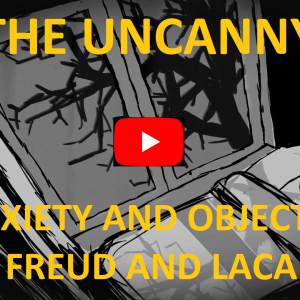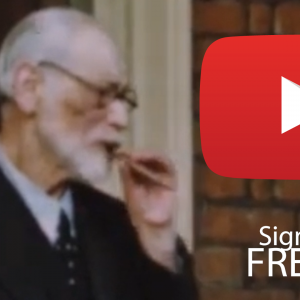Inside Out and the ‘Science’ of Emotions
No film in recent years has had quite as much input from the field of psychology as Disney and Pixar’s latest offering, Inside Out. Charming though the film is, its portrayal of emotional life tells us a lot about how current psychological theories treat the study of emotions. This gives us an excuse to contrast these ideas with the somewhat more intricate and careful theories Freud and Lacan developed on the subject.
Inside Out centres on Riley, an 11 year old girl who moves with her parents from Minnesota to San Francisco, an event which precipitates the emotional convulsions the film chronicles. The central premise is that Riley’s feelings can themselves feel. Every time an emotional experience is registered, a memory orb drops into the internal world, called Headquarters. Memory orbs affect the personified emotions – Joy, Anger, Disgust, Fear, and Sadness – characters which march on and compete with each other to take charge of the control panel in Headquarters which determines how Riley reacts.

What is an emotion? Psychologists involved in the making of Inside Out speak with great confidence about the nature of emotions. Their commentaries explaining the psychology supporting the film are peppered with phrases such as “We know…”, “Scientific studies find…”, and “The truth is…”. These are followed by quite bold claims which should demand some caution unless we are sure we know what we mean when we refer to emotional experience.
Here is one such claim, from two psychologists involved as consultants on the film:
So, our emotions are the basis for our identity and our experiences will be determined by them, or at least by those that “principally define” us. This model puts a lot of explanatory weight on emotions so it is worthwhile to start by questioning what an emotion actually is. Most fundamentally, is it so easy to identify an emotion like joy, sadness, or anger as a distinct, separate thing?
Freud and Lacan’s ideas about emotions are rich and complex. For Freud, emotions are compounds: they can be transformed, combined, or displaced. What we feel is very often the result of this process of distortion which produces a disconnect between the emotion we feel and the idea we associate with it. For instance, we may be angry at person A and produce a raft of reasons why we feel this way. But Freud was suspicious of this link. He believed it could in fact hide a grievance against a person B of which we are unconscious. His theory is that person A is chosen as the target of the anger on the grounds of an associative link, and the reasons we feel angry towards him or her are in fact rationalisations to disguise the link to person B. The job of a psychoanalysis then is to uncover the mechanism behind this link: for example, a displacement from A to B on the basis of a common feature or facet between the two characters.
This severance between an emotion and an idea is the result of repression. But strictly speaking there are no such things as repressed emotions. While an idea itself can remain unconscious – Freud thought that ideas exist in a network, as “actual structures in the system Ucs” (SE XIV, 178) – feelings tend to get expressed. Behind the emotion displayed is an idea which cannot be articulated, and so in its place comes another idea – a ‘false connection’ or rationalisation.
For this reason, Freud believed that emotions can never be taken at face value or used as an indicator of what is actually going on in a person’s life. Any emotion is susceptible to being the product of a transformation, exchange, or displacement from an unconscious idea (SE I, 188). Lacan later expressed this in stronger terms: all* emotions lie.
This then is the first problem with the psychological theories behind Inside Out and the portrayal of emotional life presented in the film itself. How do we know that what we are looking at is joy, sadness, or anger if emotions are the compound result of a process of distortion and transformation, rather than purified, precise entities? If an idea and an emotion can have different destinies in our psychical economy, then the link between any given idea and the expression of an emotion is not so clear cut, and one does not necessarily follow the other in a way that is immediately apparent.
This has important practical consequences. If an idea and an emotion have different fates, then presumably the ways of dealing with them are different too. Hence the importance of a psychotherapeutic approach that looks beyond the manifest emotion someone presents with – whether that be anger, love, fear, or sadness – rather than simply taking it at face value. Yet contrast this to the claims of psychologists involved in the making of Inside Out:
The problem with this focus on the manifest emotion is that it could absolve us from understanding why someone is sad in the first place. If we take Freud seriously, the expression of sadness can be very far removed from the experiences behind it, so a failure to recognise this could mean we address the emotion at the expense of the experience.
Inside Out offers us an example of this. Riley, the 11 year old protagonist, is forced as a result of her father’s job to move house from Minnesota to San Francisco. This is presented as an intensely upsetting experience for her, and over the course of the film we watch Riley pine for a return to her former home. But notice how, in the words of the film’s psychologist-consultants, the importance of the experience can be quietly dismissed with an appeal to the ‘science’ of emotions:
There are two problems with this. As a claim this sounds dubious in itself, but more importantly it relieves us from actually questioning what is behind Riley’s sadness. No consideration is given to the weight of the experience itself, and no attention to the specificity of what it might mean for her. One clinical psychologist – who describes herself as practicing ‘Superhero Therapy’ – easily brushes this off with “Riley initially seems to be having symptoms of an Adjustment Disorder with Depressed Mood”.

Secondly, it demonstrates a facile division that many psychological interpretations seem to cling to: that emotions can be classified as either ‘positive’ or ‘negative’, and scientific studies designed to measure this. We sense the fallacy of false precision is at work here. What measurement of ‘positivity’ would allow us to quantify an emotion like that? In the field of psychology we often find false precision used to instill a misleading confidence in a quantifiable and therefore ‘scientific’ study of emotions, even if applied to a notion that is inappropriate for quantification. Experiments that attempt to study the nature of emotions like pain or fear by threatening subjects with an electric shock, or by looking at what areas of the brain light up under neuroimaging, are all susceptible to the same critique. If we think, for example, of the pain felt in mourning a loved one, or the pain accompanying the end of a relationship, it is easy to see that the experience of pain is infinitely more complex than something which could be measured and quantified experimentally. To then deny that this is really pain on the grounds that it cannot be measured or quantified is to deny the reality of human experience. And when science is used as a justification to overrule human subjectivity this can lead to some very dark places.
Again and again in the psychological commentaries on Inside Out we find an appeal to neuroscience to cover over an unestablished premise about emotions. One psychologist commenting on the film gives us a great example of this when he confidently states that compassion is “caused by an activation of the compassion centers of our brain (the insula and the anterior cingulate cortex, among other structures)”. But how do we know that what we are seeing is compassion in the first place? We hardly have to subscribe to everything Freud said to recognise that emotions are complex, compound things; not discrete, identifiable entities that can be found in the brain.
The division of emotions in this crude way, between those which are ‘positive’ and ‘negative’, is perhaps reflected in the somewhat facile depiction of emotions in the film. The character of Sadness is blue; Joy a luminous yellow. Yes, this is a kid’s film, and using personified emotions as a narrative device in a movie about the life of an 11 year old girl is fine. Inside Out is a charming film. But this depiction of emotions belies the simplistic psychological theories underpinning it.
Worst among these is the way that emotions are presented as deficiencies in thinking, rather than as indicators that something is wrong and worth looking into. As could be expected from a Disney film, Joy is the protagonist, but each of the personified emotions parrot glib psychological language of the sort commonly found in behavioural practices like CBT. In one scene, the character of Sadness says: “Crying helps me slow down and obsess over the weight of life’s problems”.

The contrast to Freud and Lacan’s approach is stark. For the psychoanalysts, it is not the expression of the emotion – the fact that Sadness is crying – that would be of primary importance, but what “the weight of life’s problems” means for her. In a psychoanalysis, attentiveness to a person’s testimony, rather than any outward emotional manifestation, is the only route to an understanding of the experience they are going through.
An example from Freud’s 1917 paper Mourning and Melancholia may help illustrate this difference. Freud hypothesised that the experience of the loss of a loved one is what both mourning and depression have in common. But for the depressive (or melancholic) precisely who this person is and the place he or she holds in their life is not immediately obvious. Freud writes of how a mourner might be aware of whom they have lost, but not what they have lost in them (SE XIV, 245). As a result, feelings of sadness and worthlessness reported by those suffering from depression cannot be combatted by reassuring the person of their worthiness, or pointing out how wrong they are to feel the way they do. Rather, Freud suggested that we should look for a special attachment to someone in the person’s life lying behind these feelings. Sadness and worthlessness are the result of what he referred to, in a beautiful expression, as the shadow of this other person falling on the ego (SE XIV, 258). In contrast to the character in Inside Out, sadness is not about whether or not you cry, but why you cry in the first place.
Psychological commentaries on Inside Out however turn this the other way round through a privileging of the emotion:
(We will leave aside the question of what standard we could use to consider a thinking as “rational”)
The assumption here is that an emotion is a sound basis to start from; that anger, just as sadness, can be easily identified and – moreover – can “enable effective responses to the current situation”. But would we really judge the feelings of sadness and worthlessness reported by sufferers of depression as likely to “enable effective responses”? For the psychologists consulting on Inside Out the assumption of a solidity to emotion is accepted so uncritically that by extension all aspects of identity stem from it:
But as we have seen, on the Freudian model emotions are actually the shakiest premise to start from. An emotion never exists in a purified form. The characters presented in Inside Out – Anger, Disgust, Fear, Sadness, and Joy – do not exist as separate things in the brain. Instead, emotions emerge through transformations and distortions as complex compounds. The final manifestation of this process is what we perceive as a feeling, but the link between what we feel and why we think we feel it can never be taken for granted.
This model implies an important difference between the expression of an emotion and the experience of an emotion. In one scene in Inside Out, Riley’s mother asks her to support her father in moving the family to San Francisco for his job, despite Riley’s discomfort. ‘You can do that for us, can’t you?’, she pleads. Riley smiles and says ‘Sure’. Immediately, in Headquarters, Joy steps up and pushes a button on the control panel that causes Riley’s face to light up with a smile.

This nicely illustrates the difference between the expression of an emotion and the experience of an emotion. We may laugh or smile, but simply observing this outward expression is no guide to a person’s emotional experience. Emotional expressions have an intersubjective character which becomes evident in any given social situation or context: if you smile, I tend to smile; if you get angry, I am likely to get angry too. It is in the presence of other people that our emotional expressions are formed, and as such we can say that there is a mirroring function to emotion. But rather than refer to oft-cited neuropsychological theories about so-called mirror neurons to account for this, Lacan draws a more fundamental implication: that what we think of as our own emotions could actually belong to someone else. In Seminar X, Lacan highlighted the very simple point that the reaction of Pavlov’s dog was conditional on the presence of the experimenter – what Lacan called “the dimension of the Other” – incarnated by Pavlov himself (Seminar X, p.58-59). The dog, like us humans, need not be aware of this effect, which should lead us to question the solidity of constructing broad theories of personal identity on the uncertain basis of emotional expression.
What about memories? The second article on Inside Out will look at its presentation of how memory works, and the psychological theories behind it.
* Except one – anxiety. For Lacan, this is the only emotion that does not deceive (Seminar X, 19th December 1962).
By Owen Hewitson, LacanOnline.com

All content on LacanOnline.com is licensed under a Creative Commons Attribution-NonCommercial 3.0 Unported License.




“The characters presented in Inside Out – Anger, Disgust, Fear, Sadness, and Joy – do not exist as separate things in the brain. Instead, emotions emerge through transformations and distortions as complex compounds. The final manifestation of this process is what we perceive as a feeling, but the link between what we feel and why we think we feel it can never be taken for granted.”
“If anything, the lesson of Freud for me is precisely—and Freud says it when he says—accept anxiety, emotions basically lie.”-Zizek, Freud Lives!